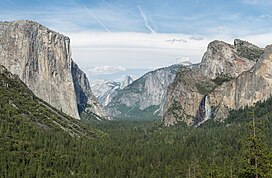| Yosemite Valley | |
|---|---|
| Ahwahnee Valley | |
 | |
| Floor elevation | 4,000 feet (1,200 m) |
| Length | 7.5 miles (12 km) E–W |
| Width | 1 mile (1.6 km) |
| Geography | |
| Coordinates | 37°43′18″N 119°38′47″W / 37.72167°N 119.64639°W |
| River | Merced River |
Yosemite Valley | |
| Area | 3,800 acres (1,500 ha) |
| Architect | Herbert Maier; Frederick Law Olmsted; Gilbert Stanley Underwood; Daniel Ray Hull; Thomas Chalmers Vint |
| Architectural style | Bungalow/Craftsman, NPS Rustic |
| NRHP reference No. | 04001159[1] |
| CHISL No. | 790[2] |
| Added to NRHP | December 14, 2006 |
Yosemite Valley (/joʊˈsɛməti/ yoh-SEM-ə-tee; Yosemite, Miwok for "killer") is a glacial valley in Yosemite National Park in the western Sierra Nevada mountains of Central California, United States. The valley is about 7.5 mi (12.1 km) long and 3,000–3,500 ft (910–1,070 m) deep, surrounded by high granite summits such as Half Dome and El Capitan, and densely forested with pines. The valley is drained by the Merced River, and a multitude of streams and waterfalls flow into it, including Tenaya, Illilouette, Yosemite and Bridalveil Creeks. Yosemite Falls is the highest waterfall in North America and is a big attraction, especially in the spring, when the water flow is at its peak. The valley is renowned for its natural environment and is regarded as the centerpiece of Yosemite National Park.
The valley is the main attraction in the park for the majority of visitors and a bustling hub of activity during tourist season in the summer months. Most visitors enter the valley from roads to the west and pass through the Tunnel View entrance. Visitor facilities are in the center of the valley. There are both hiking trail loops that stay within the valley and trailheads that lead to higher elevations.
- ^ "National Register Information System". National Register of Historic Places. National Park Service. March 13, 2009.
- ^ "Yosemite Valley". Office of Historic Preservation, California State Parks. Retrieved October 9, 2012.
